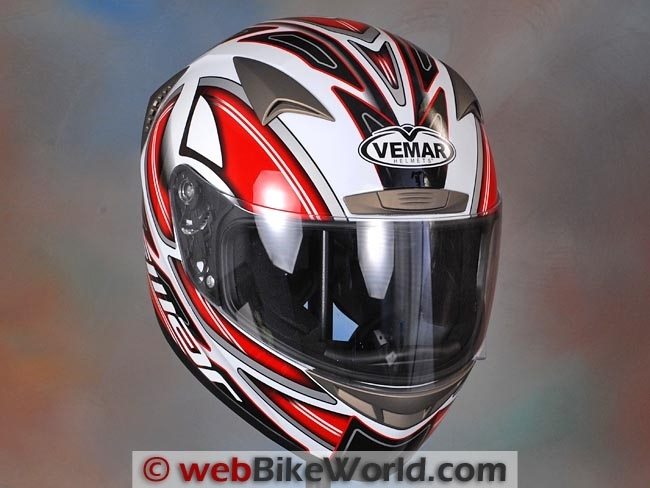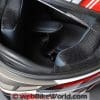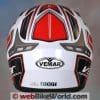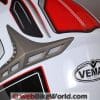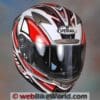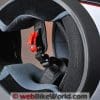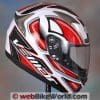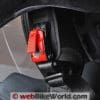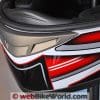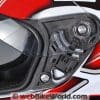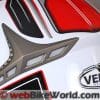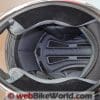The new Vemar Storm has better build quality and higher-spec features that you might expect in a helmet in this price range.
But some of those features are biased more towards style than function.
Overall, the Storm is an impressive helmet for the money.
It’s impressively quiet and comfortable and if Vemar can tweak a few of the details, the Vemar Storm could go from good to great.
The Vemar Storm is brand new for 2012, first announced in this webBikeWorld Vemar Storm preview from EICMA in Milan in November of that year.
The Storm is apparently part of a new strategy for Vemar, which bills itself as an Italian motorcycle helmet manufacturer. Some of their lower-end helmets are now made in China, rather than Italy.
This strategy brings a host of pros and cons, which we won’t get into here.
Overall, it’s not necessarily a bad thing, but what is important is for the manufacturer to maintain some level control over both the design and the implementation of that design; i.e., manufacturing and build quality.
The Storm has a lot of potential and it’s actually class-leading in many ways, including comfort, lower ventilation and noise control, which is exemplary.
But there are a few details that could be improved.
The Storm has the potential of being one of the nicest helmets available in its price range ($145.00 list), if only some of these details can be addressed.
So let’s take a closer look at the new Vemar Storm and see what you think…
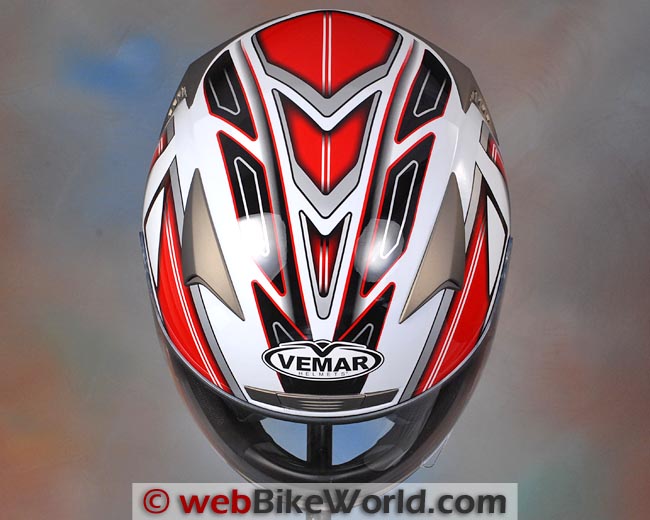
The Vemar Storm: Paint, Graphics and Overall Quality
The Editor was impressed with the quality and color choices of the Vemar Storm samples that were available at the 2011 EICMA show, detailed in his Vemar Storm preview report.
The production version of the Storm that arrived delivers on most of that potential. Overall, the Storm looks very nice, especially in the red, black and white graphics shown here, which complement the overall shape and styling of the helmet.
The clear coat feels a bit thin, however, and it includes a few tiny dust bumps here and there that can be seen upon close inspection.
The finish is probably about average for a helmet in this price range, but with just a little more care, it could be “great” rather than just “good”.
The moving parts, like the face shield and vent covers, are another matter. They are fitted with very close tolerances to the helmet shell and this helps to give the Storm a richer appearance that belies its cost.
The tight tolerances are especially good at the rear of the helmet where the exhaust vents are fitted with very narrow cut lines.
The top venting system has a sleek low-profile appearance.
But the brow vent (rare on a helmet in this price range) design is marred slightly, with a small piece of mesh sticking out one side on our helmet. Also, the brown vent design is too stiff, causing the cover to twist slightly as it opens and closes.
Styling concerns seem to have overcome functionality here, because the brow vent is difficult to open when wearing gloves. The combination of the stiff feel and the absence of a raised surface to grab means that a fingernail is required to pull it open.
Styling concerns seem to have taken precedence over functionality also with the top vents, which have a sleek look but are also difficult to open and close because of their slick surface finish.
On the other hand, the liner materials and padding have a higher quality feel than expected on a helmet in this price range and they help to make the helmet much quieter than expected, with outstanding noise control.
The face shield fits very tightly to the full-surround eye port gasket, which is also a plus.
Score: We give the Vemar Storm an “Excellent” rating for paint and build quality, all things considered. See the Summary Table at the bottom of the page for a description of our rating system.
Vemar Storm Helmet Fit, Internal Shape and Liner
This Storm is a size large and it fits as expected, with a “Neutral” to “Slight Round” internal shape that should work for a majority of rider head shapes.
The Vemar size chart calls for a 59-60 cm size large and that seems correct.
Depending on your head shape, you may be able to shade it slightly either over or under.
Squeeze the padding with your hand as you grab the helmet and it doesn’t feel extraordinary, but somehow it does an excellent job at maintaining comfort levels while also providing exceptional noise control.
One evaluator who wore the helmet asked if the helmet had some type of special noise reduction lining.
We don’t think this is the case, but a good combination of overall aerodynamics and quality internal materials, along with good fit, make the difference here.
The liner material is very soft and it has a silky-smooth feel. The only downside is that the material is prone to pilling on beard stubble, so male owners may want to shave first before riding! Or, grow a healthy beard…
The black material along the bottom of the “neck roll” on the helmet also has a rich feel, but it picks up lint fairly quickly. This is easy enough to wipe clean, however.
The ear pockets are generous and not too deep. They are lined with fabric and overall the dimensions and depth make for an excellent platform for mounting intercom speakers.
The fit between the liner and the shell is very tight, making it difficult to mount an intercom using a clamp, so the double-sided tape routine is a better choice here.

Score: We’ll give the Vemar Storm an “Outstanding” rating for fit and comfort and internal shape.
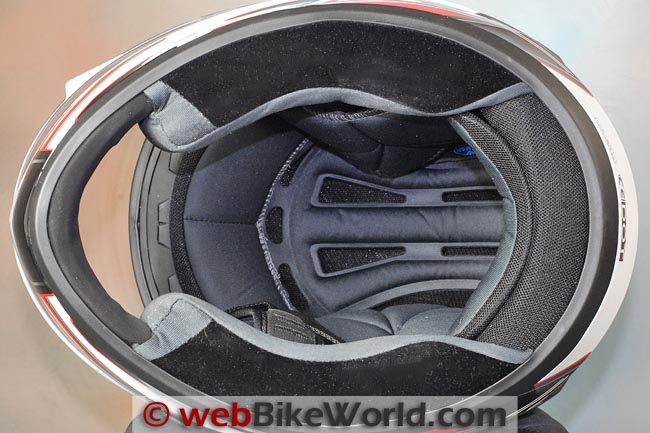
Vemar Storm Face Shield, Eye Port and Visibility
The face shield fitted to the Vemar Storm fits very tightly against the eye port gasket. The gasket fully surrounds the eye port, which seals out water.
The lift tab is located quite far to the left, and the face shield feels tight enough that working the face shield up and down gives a feeling that there will be some twisting or torque. But once the helmet is on, the shield lifts smartly through its detents.
It doesn’t have a small first detent position for defogging, but if you lift the shield and then carefully lower it again, it can be stopped just before it closes all the way.
Vemar says the face shield is anti-fog and anti-scratch treated. They also claim 2.2 mm for the face shield thickness; ours averages 2.3 mm, well within the tolerance range.
The helmet has slightly better than average outward visibility in the vertical and horizontal planes.
The face shield removal mechanism is easy to use while providing a firm feel. Once the face shield is opened all the way, pull down on a ring tab and pull the face shield out.
Three small plastic tabs are pushed back in and seated to replace the shield, which can then be rotated downwards. The Vemar Storm does not have an internal rotating sun visor, and that’s fine with us.

Score: We’ll give the Vemar Storm an “Outstanding” rating in this category for the face shield and eye port design.
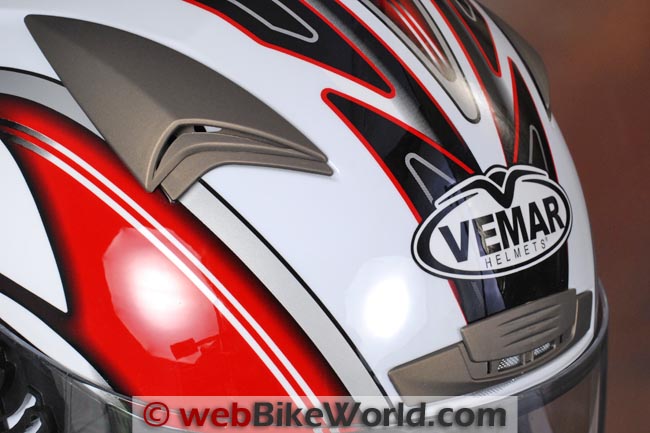
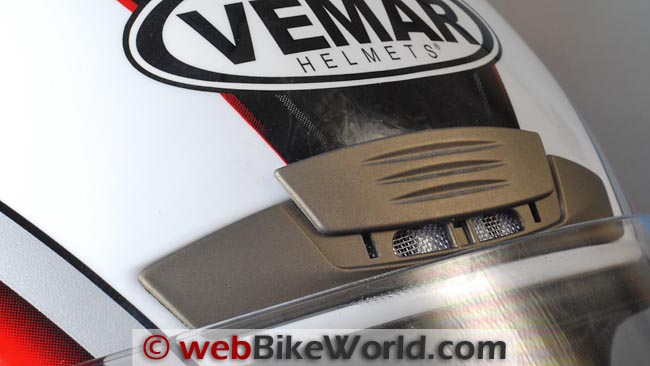
Vemar Storm Ventilation and Air Flow
The chin vent of the Vemar STorm has a unique design. The vent slider switch is located inside the chin bar, so there is no external control for the chin vent.
The slider is accessed by sticking a thumb up inside the chin bar to flip the switch open or closed.
Unfortunately, the slider is recessed in a horizontal channel, making it can be difficult to find and operate when wearing thicker winter gloves.
Also, putting the slider inside the chin bar meant that Vemar couldn’t install a chin curtain on the Storm, because it would make accessing the chin vent slider switch more difficult.
This is too bad, because the helmet could really use a chin curtain; quite a bit of air flows up from under the chin bar.
Most helmets today come with a chin curtain, and for good reason.
Perhaps Vemar could have or should have provided a chin curtain to be optionally installed by the owner. Granted, it might make operating the internal chin vent slider switch more difficult, but I think the tradeoff would be worth it.
The chin vent has three large vent ports through the chin bar, so a lot of air flows through the vent.
This is a definite plus and much appreciated, especially compared to (too many) helmets made today which have no direct air venting through the chin bar.
The top vents and brow vent also flow a decent volume of air, which moves between the liner and the EPS and out the exhaust ports in the rear of the helmet.
Overall, I’d have to rate the ventilation of the Vemar Storm as Excellent.

Score: The Vemar Storm ventilation system gets an “Excellent” rating, with better-than-average ventilation top and bottom.
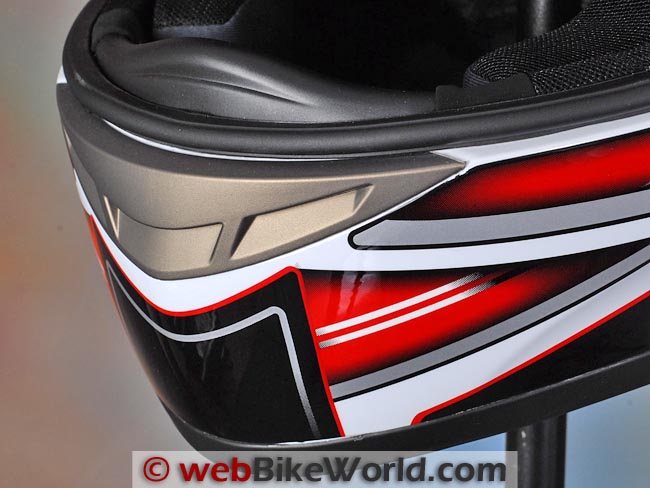
Vemar Storm Sound Levels
The smooth shape of the Vemar Storm, combined with the tight tolerances where the vent pieces are attached, and the also-tight-fitting face shield — along with the comfortable padding — give the helmet excellent to outstanding noise control.
The low noise levels were noticed right away by more than one evaluator, as soon as they started their rides.
It’s interesting how one helmet can do such a good job at controlling noise compared to a different helmet, and the features that make these differences aren’t always noticeable.
It’s sort of a combination of various design features, probably mixed with a healthy dose of luck.
When the top vents are open and the head is turned side-to-side, some wind noise is noticeable as the air passed over the vent openings, but overall, the Vemar Storm is a quiet helmet (relatively speaking, of course).

Note that our helmet evaluations are a combined effort of several riders over time on different types of motorcycles with and without windscreens.
Evaluators wear correctly fitted, high quality ear plugs (even when evaluating motorcycle intercom systems).
Always protect your hearing when riding a motorcycle. See the wBW Earplug Reviews for more information on choosing and wearing earplugs.
Note also that perceived noise levels will vary, depending on the individual.
Noise can be caused by many factors, including helmet fit, the type of motorcycle and windscreen, wind speed and direction and even the rider’s clothing.
For more information on helmet noise, visit the wBW Motorcycle Helmet Noise page.
Score: We’ll give the Vemar Storm an “Oustanding” rating for better than average overall (low) noise levels.
Helmet Weight
This size large Vemar Storm, with its polycarbonate shell, weighs 1637 grams (3 lbs., 9-3/4 oz.).
That’s almost exactly the average weight of the 180+ helmets reviewed to date on webBikeWorld.com, which is a pretty good showing.
Just for random comparison, helmets in the Storm’s weight range include the Icon Mainframe (review) in size XL weighs 1632 grams and the Caberg Duke (review) flip-up in size L at 1633 grams.
Also the Shoei X-Eleven (review) in size XL weighs 1635 grams and the ROOF Boxer V (review) flip-up in size L is 1638 grams.
The comfortable fit and relatively low weight of the Vemar Storm are definite positives. The helmet does feel like it has a bit of lift when riding at higher speeds, which is unusual for modern helmet designs.
Note also that all of the helmets reviewed on webBikeWorld have been weighed and the weights are available on the wBW Motorcycle Helmet Weights page
Also see the chart that lists the helmets by weight and shape on the wBW Motorcycle Helmet Shapes page.
Score: The Vemar Storm gets an “Excellent” rating for weight with good balance.
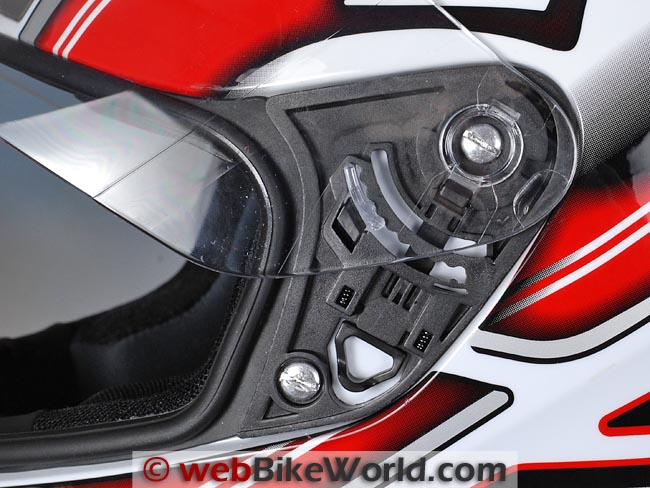
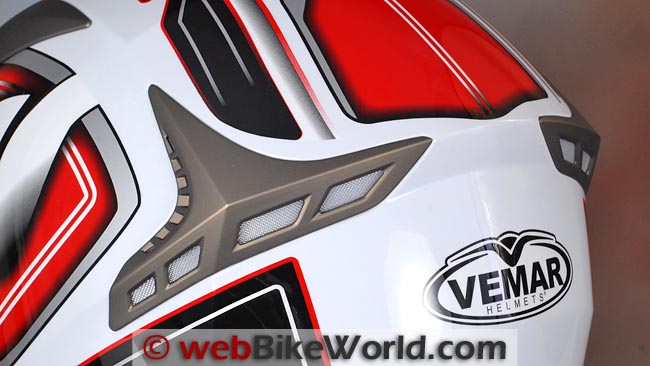
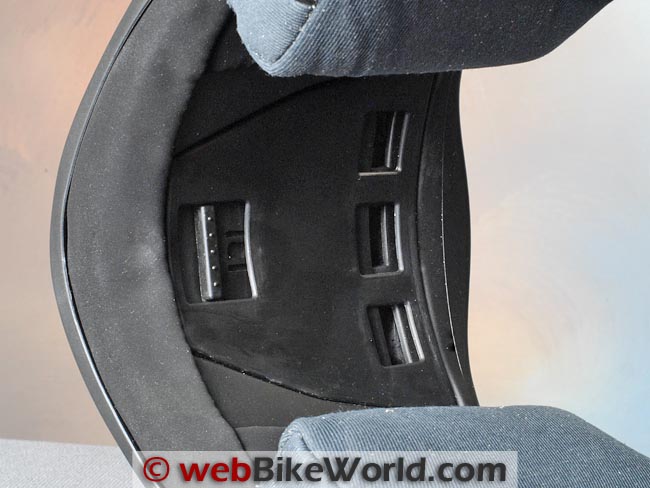
Miscellaneous
The Vemar Storm chin strap has a “microlock” chin strap retainer. We prefer the tried-and-true D-ring system.
Two of the evaluators noted th
at the microlock system on the Vemar Storm felt uncomfortable, due to its location and shape. Also, there is nothing to hold the extra length of chin strap once it’s adjusted to the individual rider.
The helmet meets the DOT safety standard when sold in the U.S. and the ECE 22.05 standard when sold in Europe.
| webBikeWorld Overall Opinionator: Vemar Storm | |
|---|---|
| Picks… | …and Pans |
|
|
Conclusion
The new Vemar Storm is a bit of a paradox. It offers a lot for the money, with a nicely made, comfortably plush and silent interior, good overall looks and close-fitting tolerances on the plastic bits.
But a few minor issues could be addressed to turn this into a real winner in the sub-$150 category.
The most frustrating parts are the vents, which look great and actually work pretty well but are difficult to open and close.
It’s not uncommon to find balky switchgear on either the top vent(s) or the chin vent, but in this case, all four vents have issues. The top vents are too smooth and difficult to grab.
The brow vent is too stiff to operate and the chin vent switch is flush with the inside of the chin bar, making operation difficult when wearing gloves.
These cons don’t necessarily outweigh the pros; indeed, the Vemar Storm has better than expected ventilation, excellent noise control, a comfortable interior and a tight-fitting face shield.
If you’re OK with setting the vent openings before you start your ride, you’ll probably never notice these issues and you’ll be wearing a very satisfying sub-$150 helmet.
| wBW Review: Vemar Storm Helmet | |
|---|---|
| Manufacturer: Vemar Helmets | List Price (2012): $135.00-$145.00. |
| Colors: Black, Matte Black, White. Red, Blue or Black Graphics. | Made In: China |
| Sizes: S-2XL Shell Sizes: Unknown | Review Date: March 2012 |
|
Rating Scale is subjective: Unacceptable, Poor, Neutral, Very Good, Excellent, Outstanding.
|
|
Note: Item provided by a retailer, distributor or manufacturer with these Terms and Conditions.
Owner Comments and Feedback
See details on submitting comments.
From “W” (April 2012): “Hello, I bought a GSB G-335 helmet recently. It’s the FRP shell and ECE version (of the) Vemar Storm. Pictures are here in this forum link thread.
I agree the liner is comfortable, but the fit about the cheeks is not very good, the bottom of the cheeks have a small gap with my face.
Both sides of the rubber of eye port have a small gap, too. It will make noise (but) after adjusting the shield base, it will improve.
I agree the airflow of the chin/face is above average, but I think the top/upper is not good enough. I will find the chin cover and breath cover for this helmet, maybe need to modify. Thanks your information.”
Follow-up From “W” (April 2012): “I found an available chin cover and breath cover. The chin cover is from THH, used in the TS-41 (AFX FX-95) helmet. But it needs slight trimming of the board.
The breath cover is from Zeus, used in the Zeus ZS-1200/806/803, and it doesn’t need to be modified. There are pictures in the forum link.


